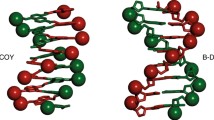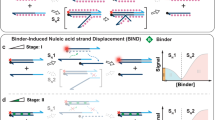Abstract
SMALL molecules that specifically bind with high affinity to any predetermined DNA sequence in the human genome would be useful tools in molecular biology and potentially in human medicine. Simple rules have been developed to control rationally the sequence specificity of minor-groove-binding polyamides containing N-methylimidazole and N-methylpyrrole amino acids. Two eight-ring pyrrole–imidazole polyamides differing in sequence by a single amino acid bind specifically to respective six-base-pair target sites which differ in sequence by a single base pair. Binding is observed at subnanomolar concentrations of ligand. The replacement of a single nitrogen atom with a C-H regulates affinity and specificity by two orders of magnitude. The broad range of sequences that can be specifically targeted with pyrrole–imidazole polyamides, coupled with an efficient solid-phase synthesis methodology, identify a powerful class of small molecules for sequence-specific recognition of double-helical DNA.
Similar content being viewed by others
References
Wade, W. S., Mrksich, M. & Dervan, P. B. J. Am. chem. Soc. 114, 8783–8794 (1992).
Mrksich, M. et al. Proc. natn. Acad. Sci. U.S.A. 89, 7586–7590 (1992).
Wade, W. S., Mrksich, M. & Dervan, P. B. Biochemistry 32, 11385–11389 (1993).
Pelton, J. G. & Wemmer, D. E. Proc. natn. Acad. Sci. U.S.A. 86, 5723–5727 (1989).
Pelton, J. G. & Wemmer, D. E. J. Am. chem. Soc. 112, 1393–1399 (1990).
Mrksich, M. & Dervan, P. B. J. Am. chem. Soc. 115, 2572–2576 (1993).
Geierstanger, B. H., Jacobsen, J. P., Mrksich, M., Dervan, P. B. & Wemmer, D. E. Biochemistry 33, 3055–3062 (1994).
Geierstanger, B. H., Dwyer, T. J., Bathini, Y., Lown, J. W. & Wemmer, D. E. J. Am. chem. Soc. 115, 4474–4482 (1993).
Geierstanger, B. H., Mrksich, M., Dervan, P. B. & Wemmer, D. E. Science 266, 646–650 (1994).
Mrksich, M. & Dervan, P. B. J. Am. chem. Soc. 117, 3325–3332 (1995).
Mrksich, M. & Dervan, P. B. J. Am. chem. Soc. 115, 9892–9899 (1993).
Dwyer, T. J., Geierstanger, B. H., Mrksich, M., Dervan, P. B. & Wemmer, D. E. J. Am. chem. Soc. 115, 9900–9906 (1993).
Mrksich, M. & Dervan, P. B. J. Am. chem. Soc. 116, 3663–3664 (1994).
Mrksich, M., Parks, M. E. & Dervan, P. B. J. Am. chem. Soc. 116, 7983–7988 (1994).
Chen, Y. H. & Lown, J. W. J. Am. chem. Soc. 116, 6995–7005 (1994).
Cho, J. Y., Parks, M. E. & Dervan, P. B. Proc. natn. Acad. Sci. U.S.A. 92, 10389–10392 (1995).
Baird, E. E. & Dervan, P. B. J. Am. chem. Soc. 118, 6141–6146 (1996).
Galas, D. & Schmitz, A. Nucleic Acids Res. 5, 3157–3170 (1978).
Fox, K. R. & Waring, M. J. Nucleic Acids Res. 12, 9271–9285 (1984).
Brenowitz, M., Senear, D. F., Shea, M. A. & Ackers, G. K. Meth. Enzym. 130, 132–181 (1986).
Steitz, T. A. Rev. Biophys. 23, 205–280 (1990).
Desjarlais, J. R. & Berg, J. M. Proc. natn. Acad. Sci. U.S.A. 89, 7345–7349 (1992).
Desjarlais, J. R. & Berg, J. M. Proc. natn. Acad. Sci. U.S.A. 90, 2256–2260 (1993).
Jamieson, A. C., Kim, S.-H. & Wells, J. A. Biochemistry 33, 5689–5695 (1994).
Rebar, R. J. & Pabo, C. O. Science 263, 671–673 (1994).
Choo, Y. & Klug, A. Proc. natn. Acad. Sci. U.S.A. 91, 11163–11167 (1994).
Choo, Y. & Klug, A. Proc. natn. Acad. Sci. U.S.A. 91, 11168–11172 (1994).
Letovsky, J. & Dynan, W. S. Nucleic Acids Res. 17, 2639–2653 (1989).
Maxam, A. M. & Gilbert, W. S. Meth. Enzym. 65, 499–560 (1980).
Iverson, B. L. & Dervan, P. B. Nucleic Acids Res. 15, 7823–7830 (1987).
Author information
Authors and Affiliations
Rights and permissions
About this article
Cite this article
Trauger, J., Baird, E. & Dervan, P. Recognition of DNA by designed ligands at subnanomolar concentrations. Nature 382, 559–561 (1996). https://doi.org/10.1038/382559a0
Received:
Accepted:
Issue Date:
DOI: https://doi.org/10.1038/382559a0
- Springer Nature Limited
This article is cited by
-
Targeting cis-regulatory elements of FOXO family is a novel therapeutic strategy for induction of leukemia cell differentiation
Cell Death & Disease (2023)
-
Targeting MYC with modular synthetic transcriptional repressors derived from bHLH DNA-binding domains
Nature Biotechnology (2023)
-
A RUNX-targeted gene switch-off approach modulates the BIRC5/PIF1-p21 pathway and reduces glioblastoma growth in mice
Communications Biology (2022)
-
Telomere-specific chromatin capture using a pyrrole–imidazole polyamide probe for the identification of proteins and non-coding RNAs
Epigenetics & Chromatin (2021)





